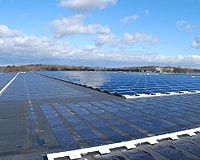 |
Scottsdale AZ (SPX) May 20, 2009 Five families participating in Habitat for Humanity's new homeowner program will be moving into solar-powered homes this year as a result of an industry partnership coordinated by American Solar Electric. The solar electric systems are being donated by American Solar Electric to Habitat for Humanity as part of the company's 2009 Community Outreach Program. The systems range in size from 2.73 to 3.15 kilowatts and are comprised of Kyocera high output 210-watt photovoltaic (PV) modules and high-efficiency Fronius IG and IG+ inverters. Electricity generated by the solar electric systems will be used to offset utility power, thereby reducing the cost of electricity for the new homeowners. The systems are forecasted to produce between 4,700 and 5,500 kilowatt-hours of electricity in their first year of production. "Even as our local economy has slowed, the local solar industry has continued to boom," said Sean Seitz, president of American Solar Electric. "Thanks to our continued success and the contributions made by our employees and industry partners, we've been able to increase the number of solar projects we donate to Habitat for Humanity from two in 2008 to five in 2009." "Solar systems are not only a great source of clean energy but they significantly lower monthly electricity bills as well," said U.S. Rep. Harry Mitchell. "At a time when many people are struggling economically, Habitat for Humanity's energy efficient homes will help insulate these families from rising energy costs." In addition to American Solar Electric's donation of system components, employees of American Solar Electric and Kyocera are donating their time and expertise to install the systems. Additionally, Fronius has agreed to supply high-efficiency inverters for the projects at discounted prices. "The partnership with American Solar Electric has a significant impact on Habitat's ability to build affordable homes," said Roger Schwierjohn, president and CEO of Habitat for Humanity Central Arizona. "We appreciate American Solar's commitment to renewable energy and to the families we serve." "We, at Kyocera, are pleased that our employees are volunteering their time to help Habitat for Humanity improve the human condition and the environment by installing pollution-free solar energy on homes," stated Steve Hill, president of Kyocera Solar, Inc. "Fronius is excited to be a part of Habitat for Humanity's efforts to create sustainable affordable housing," said Gord Petroski, director, Fronius USA, Solar Division. "Long-term planning is a core value at Fronius, and we are proud our inverters will be a part of the systems that will help keep these homes affordable into the future." It is the goal of Habitat for Humanity to achieve Leadership in Energy and Environmental Design (LEED) certification on all five homes. One of the homes will be featured as part of the Greenbuild International Conference and Expo coming to Phoenix on November 11-13. This featured home has been designed to be a 'net zero energy' home; meaning the energy generated with renewable resources is as much energy as the homeowners would use on a net annual basis. Three homes are expected to be completed in the spring with two more this fall. Share This Article With Planet Earth
Related Links American Solar Electric Habitat for Humanity Central Arizona Kyocera Solar All About Solar Energy at SolarDaily.com
 Rapid Growth Projected For Chemicals And Materials In Solar Cells And Modules
Rapid Growth Projected For Chemicals And Materials In Solar Cells And ModulesBoston MA (SPX) May 20, 2009 The market for advanced chemicals and materials used in PV solar cells and modules will decline in 2009 to $2.3 billion before resuming strong growth to approximately $15 billion by 2015, according to a new industry analysis report from Linx-AEI Consulting, a leading international consulting firm serving the photovoltaics and electronics industries. The new report entitled Chemicals and Ma ... read more |
|
| The content herein, unless otherwise known to be public domain, are Copyright 1995-2009 - SpaceDaily. AFP and UPI Wire Stories are copyright Agence France-Presse and United Press International. ESA Portal Reports are copyright European Space Agency. All NASA sourced material is public domain. Additional copyrights may apply in whole or part to other bona fide parties. Advertising does not imply endorsement,agreement or approval of any opinions, statements or information provided by SpaceDaily on any Web page published or hosted by SpaceDaily. Privacy Statement |